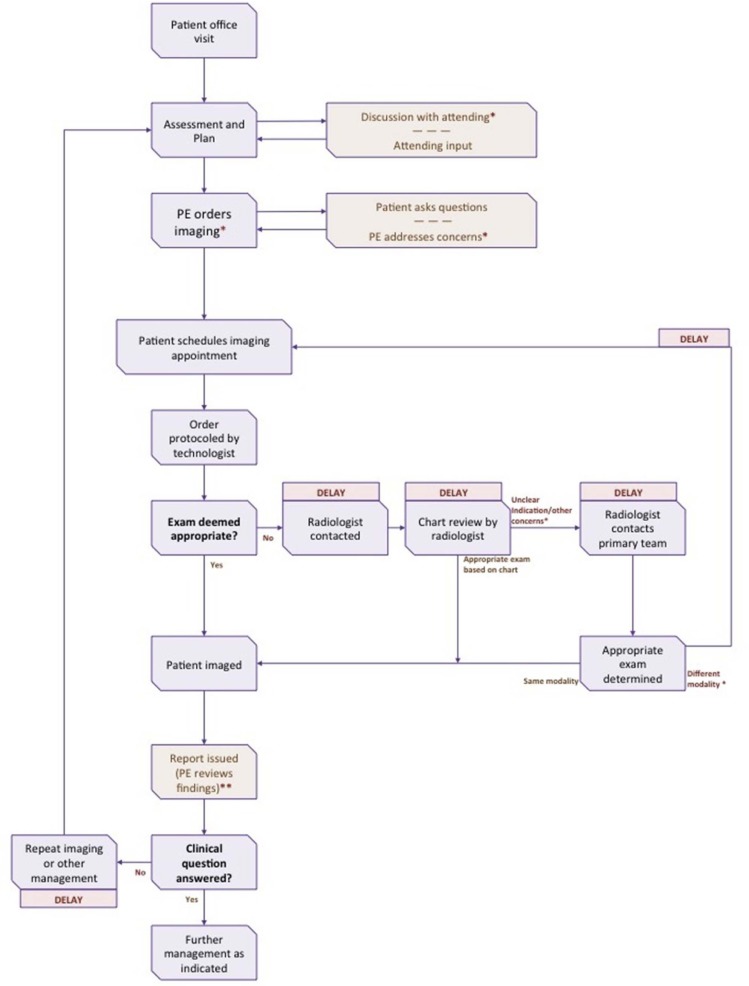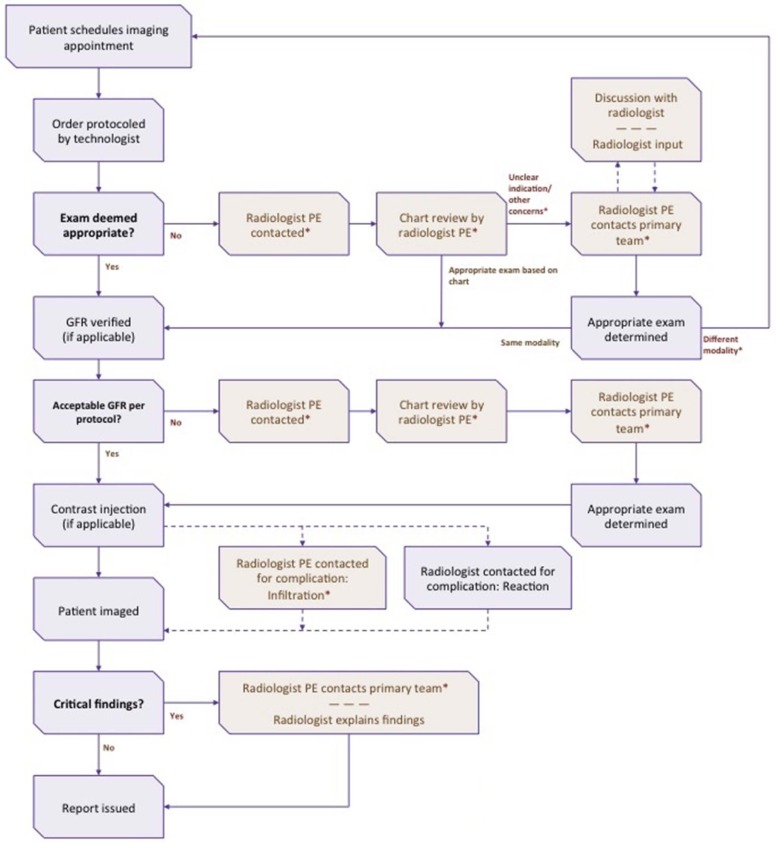As physician extenders (PEs) enter the medical community in large numbers, they have an increasing impact on imaging utilization and imaging-based procedures. Physician assistants (PAs) and nurse practitioners (NPs) have an advanced level of education and some practice autonomously. However, PA and NP programs are not required to provide any basic radiology education. For PEs who did receive basic radiology education during their graduate program, the curriculum is nonstandard and there is a wide variation. PEs working in primary care and nonradiology specialties place imaging orders, review report findings, and answer patient questions. Other PEs working within radiology practices operate as liaisons with patients in diagnostic radiology or perform an increasing number of interventional procedures. Basic radiology education in formal PE certificate programs as well as on-the-job education about radiology may benefit patients, radiologists, and the health-care system. What role, if any, should the radiologist assume for educating PE students and practicing PAs and NPs? This review analyzes the benefits and drawbacks of radiologists educating PEs.
Introduction
The emergence of physician extenders (PEs) across all medical specialties to meet increasing demands for health care has changed the delivery of primary care and specialty services. Two main groups of PEs, physician assistants (PAs) and nurse practitioners (NPs), have seen a dramatic increase in career growth and some practice autonomously . As both primary care and specialty PEs assume greater responsibilities in patient care, they may interact with radiology in new capacities such as reviewing imaging report findings, discussing recommendations with patients, and assisting with or performing basic interventional procedures within a radiology practice. However, despite advancements in radiology over the past several decades and increasing responsibilities of PEs, there are no formal radiology education requirements for PA and NP certification programs .
PA and NP programs were originally created in 1965 at Duke University and the University of Colorado, respectively, to combat a shortage of primary care physicians . Currently, over 95,000 PAs and 192,000 NPs work in all 50 states, with more than 6000 new PAs graduating from 219 national programs each year . Both professions have experienced higher-than-average growth; the U.S. Bureau of Labor Statistics projects continued growth at 30% for PAs and 31% for NPs between 2014 and 2024 . By contrast, the average growth for all occupations is 7% . Although matriculation prerequisites including minimum degree requirements vary between PA programs, the Accreditation Review Commission on Education for the Physician Assistant and the Physician Assistant National Certifying Exam set standards for all PAs. Both organizations require the ability to generate a differential diagnosis, to order, and to interpret laboratory and diagnostic studies . NP certification is awarded by The Accreditation Board for Specialty Nursing Certification, which similarly describes an ability to order, perform, supervise, and interpret laboratory and imaging studies . However, neither PA nor NP certification agency requirements refer to principles of radiology, radiological procedures, radiation safety, or radiobiology . The extent of radiology education is thus school dependent and variable.
The majority of PAs accept positions in family medicine or general practice . In such a context, these providers perform much of their own diagnostic workups, including what type of imaging, if any, is warranted. PEs working as part of a specialty team may also have a primary role in ordering and following up with imaging results. On the other hand, some PEs may find employment within a radiology group, where he or she may be expected to learn to perform basic fluoroscopy examinations on the job and without required formal training or certification in at least 20 states . Some may be expected to learn and perform basic procedures on the job in interventional radiology (IR). Given that many PEs may have had minimal or no radiology education yet impact imaging utilization, what role, if any, can the radiologist assume in diagnostic and IR education for PEs?
Education of PEs Working in Primary Care or Nonradiology Specialties
Determining the type of diagnostic imaging to order, answering patient questions, and understanding radiology report findings may be a difficult or uncomfortable process for PEs without sufficient prior radiology education. Inappropriate imaging studies may delay patient care, increase health-care costs, or expose patients to unnecessary ionizing radiation . Unfamiliarity with common radiology report findings may also lead to misunderstanding, miscommunication, and improper patient management. Targeted radiology education of PEs focusing on a few key points within the diagnostic radiology workflow may reduce the possibility of these negative consequences ( Fig 1 ).
Order Appropriateness
Get Radiology Tree app to read full this article<
Get Radiology Tree app to read full this article<
Get Radiology Tree app to read full this article<
Get Radiology Tree app to read full this article<
Addressing Patient Questions
Get Radiology Tree app to read full this article<
Understanding Report Findings
Get Radiology Tree app to read full this article<
Get Radiology Tree app to read full this article<
Education of PEs Working in Radiology Departments
Get Radiology Tree app to read full this article<
Get Radiology Tree app to read full this article<
Protocols and Contrast Material Issues
Get Radiology Tree app to read full this article<
Direct Patient Care
Get Radiology Tree app to read full this article<
Fluoroscopic and IR Procedures
Get Radiology Tree app to read full this article<
Get Radiology Tree app to read full this article<
Get Radiology Tree app to read full this article<
Get Radiology Tree app to read full this article<
Get Radiology Tree app to read full this article<
Get Radiology Tree app to read full this article<
Conclusions
Get Radiology Tree app to read full this article<
Get Radiology Tree app to read full this article<
References
1. NCCPA: National Commission on Certification of Physician Assistants : 2013 Statistical profile of certified physician assistants: an annual report of the NCCPA.2014.
2. Bureau of Labor Statistics, U.S. Department of Labor : Occupational outlook handbook, 2016–2017 edition, physician assistants Dec 2015. Available at: https://www.bls.gov/ooh/healthcare/physician-assistants.htm
3. Bureau of Labor Statistics, U.S. Department of Labor : Occupational outlook handbook, 2016–2017 edition, nurse anesthetists, nurse midwives, and nurse practitioners, Dec 2015. Retrievable at: https://www.bls.gov/ooh/healthcare/nurse-anesthetists-nurse-midwives-and-nurse-practitioners.htm
4. Nordeck S.M., Sanders V.L., Killion J.B.: Comparative analysis of physician extender curricular requirements in radiology: a detailed view. J Am Coll Radiol 2012; 9: pp. 270-274.
5. American Academy of Physician Assistants : Milestones in history of PAs. Retrievable at: https://www.aapa.org/workarea/downloadasset.aspx?id=789 Accessed 4/2016
6. Physician Assistant Education Association : PAEA program directory. Retrievable at: http://directory.paeaonline.org Accessed 11/10/2016
7. Accreditation Review Commission on Education for the Physician Assistant Inc : Accreditation standards for physician assistant education.Fourth ed.2010.
8. NCCPA: National Commission on Certification of Physician Assistants : PANCE exam content blueprint tasks.2016.
9. APRN Consensus Work Group & the National Council of State Boards of Nursing APRN Advisory Committee: APRN joint dialogue group report. Consensus model for APRN regulation: licensure, accreditation, certification & education. Retrievable at: http://www.nursingcertification.org/wp-content/uploads/2015/09/Approved-Consensus-Document-7-20081.pdf Accessed 7/2016
10. Hendee W.R., Becker G.J., Borgstede J.P., et. al.: Addressing overutilization in medical imaging. Radiology 2010; 257: pp. 240-245.
11. Hemani A., Rastegar D.A., Hill C., et. al.: A comparison of resource utilization in nurse practitioners and physicians. Eff Clin Pract 1999; 2: pp. 258-265.
12. Hughes D.R., Jiang M., Duszak R.: A comparison of diagnostic imaging ordering patterns between advanced practice clinicians and primary care physicians following office-based evaluation and management visits. JAMA Intern Med 2015; 175: pp. 101-107.
13. American College of Radiology : ACR appropriateness criteria overview.2015.
14. Baker S.R., Merkulov A.: The radiology assistant: a contrarian’s view. Emerg Radiol 2005; 11: pp. 187-192.
15. Fazel R., Krumholz H.M., Wang Y., et. al.: Exposure to low-dose ionization radiation from medical imaging procedures. N Engl J Med 2009; 361:
16. Smith-Bindman R., Miglioretti D.L., Johnson E., et. al.: Use of diagnostic imaging studies and associated radiation exposure for patients enrolled in large integrated health care systems, 1996–2010. JAMA 2012; 307: pp. 2400-2409.
17. Bruno M.A., Petscavage-Thomas J.M., Mohr M.J., et. al.: The “open letter”: radiologists’ reports in the era of patient web portals. J Am Coll Radiol 2014; 11: pp. 863-867.
18. Landro L.: Radiologists push for medical reports patients can understand. Wall St J 2014; Retrieved from: http://www.wsj.com/articles/radiologists-push-for-medical-reports-patients-can-understand-1410724814
19. Bowen M.A., Torres W.E., Small W.C.: Nonphysician providers in radiology: the Emory University Experience. Radiology 2007; 245: pp. 3-6.
20. Duszak R., Walls D.G., Wang J.M., et. al.: Expanding roles of nurse practitioners and physician assistants as providers of nonvascular invasive radiology procedures. J Am Coll Radiol 2015; 12: pp. 284-289.
21. Balint B.J., Steenburg S.D., Lin H., et. al.: Do telephone call interruptions have an impact on radiology resident diagnostic accuracy?. Acad Radiol 2014; 21: pp. 1623-1628.
22. Yu J.P., Kansagra A.P., Mongan J.: The radiologist’s workflow environment: evaluation of disruptors and potential implications. J Am Coll Radiol 2014; 11: pp. 589-593.
23. Levine M.S., Rubesin S.E., Laufer I.: Barium studies in modern radiology: do they have a role?. Radiology 2009; 250: pp. 18-22.
24. Duszak R., Bilal N., Picus D., et. al.: Central venous access: evolving roles of radiology and other specialties nationally over two decades. J Am Coll Radiol 2013; 10: pp. 603-612.
25. Hawkins C.M., Bowen M.A., Gilliland C.A., et. al.: The impact of nonphysician providers on diagnostic and interventional radiology practices: operational and educational implications. J Am Coll Radiol 2015; 12: pp. 898-904.
26. National Council of State Boards of Nursing : CRNA independent practice map. NCSBN’s APRN campaign for consensus: state progress toward uniformity. Retrievable at: https://www.ncsbn.org/5404.htm Accessed 11/8/2015
27. Elayda S.: FTC advocacy at the state level memorandum.2012.
28. Drew B.J., Dracup K., Childers R., et. al.: Finding ECG readers in clinical practice: is it time to change the paradigm?. J Am Coll Cardiol 2014; 64: pp. 528.
29. Blackmore C.C., Hoffer E.K., Albrecht E., et. al.: Physician assistants in academic radiology: the Harborview experience. J Am Coll Radiol 2004; 1: pp. 410-414.
30. Thrall J.H.: The invisible radiologist: an address to a residency graduating class. J Am Coll Radiol 2013; 10: pp. 153-155.
31. Forman H.P., Javitt M.C., Monsees B., et. al.: Masters of radiology panel discussion: radiology extenders—challenges and opportunities to balance the demands of our changing work environment. AJR Am J Roentgenol 2010; 195: pp. 170-175.
32. American College of Radiology : Imaging 3.0 FAQ. https://www.acr.org/FAQs/Imaging-3-FAQ Accessed 7/1/2016
33. Bureau of Labor Statistics : May 2014 national occupational employment and wage estimates United States. Retrievable at: http://www.bls.gov/oes/current/oes_nat.htm#29-0000 Accessed 11/8/2015

